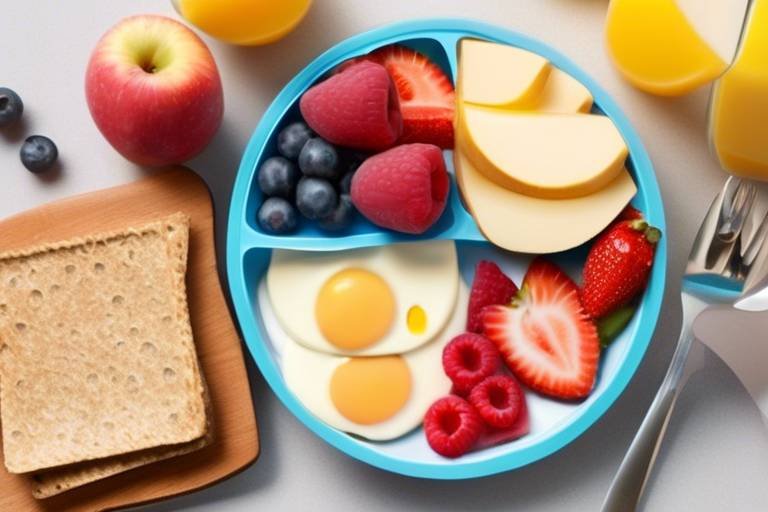Healthy Low Sugar Desserts for One and All
When it comes to satisfying your sweet tooth, the world of desserts can often feel like a minefield, especially if you're trying to watch your sugar intake. But fear not! There’s a whole universe of healthy low sugar desserts out there just waiting to be explored. Imagine indulging in a luscious chocolate mousse or a fruity sorbet without the guilt that usually accompanies sugary treats. Sounds dreamy, right? Well, it’s entirely possible, and this article is here to guide you through a variety of options that cater to different tastes and dietary needs. Whether you’re a chocolate lover, a fruit fanatic, or someone who craves creamy textures, we’ve got something for everyone.
Low sugar desserts not only satisfy your cravings but also come with a plethora of health benefits. Think of them as your sweet allies in maintaining a balanced diet. They can help with weight management, reduce the risk of chronic diseases, and even improve your energy levels. So, why not treat yourself without sacrificing your health? After all, who said desserts can’t be both delicious and nutritious? By incorporating these delightful options into your diet, you’re making a smart choice that your taste buds and your body will thank you for.
But what exactly makes a dessert “low sugar”? It’s all about the ingredients! In the following sections, we’ll dive deeper into the essential components that make these desserts not just healthy, but also incredibly tasty. From natural sweeteners that replace refined sugar to whole grains that add fiber and nutrients, you’ll discover how easy it is to whip up something delightful without a mountain of sugar. So grab your aprons, because we’re about to embark on a sweet yet healthy journey that everyone can enjoy!

Benefits of Low Sugar Desserts
Have you ever wondered why so many people are making the switch to low sugar desserts? The benefits are not just a passing trend; they are rooted in solid health advantages that can enhance your overall well-being. First and foremost, incorporating low sugar desserts into your diet can help with weight management. Traditional desserts often pack a hefty punch of sugar, which can lead to unwanted weight gain. By choosing desserts that are lower in sugar, you can satisfy your sweet tooth without the guilt or the extra calories.
Moreover, reducing sugar intake can significantly decrease the risk of chronic diseases. High sugar consumption is linked to conditions such as diabetes, heart disease, and even certain cancers. By opting for healthier dessert alternatives, you are taking proactive steps to protect your health. Imagine treating yourself to a delicious dessert while simultaneously lowering your risk of these serious health issues. It’s like hitting two birds with one stone!
Another perk of low sugar desserts is the boost in energy levels. Foods high in sugar can lead to quick spikes in energy followed by crashes that leave you feeling lethargic. In contrast, desserts with lower sugar content tend to provide a more stable energy release. This means you can enjoy your treat without the dreaded sugar crash that often follows. You’ll feel more energized and ready to tackle whatever the day throws at you!
In addition to these benefits, low sugar desserts can also improve your overall mood. High sugar diets have been associated with mood swings and irritability. By choosing desserts that are lower in sugar, you may find yourself feeling more balanced and content. It’s a sweet way to keep your spirits high!
Let’s not forget about the variety that low sugar desserts bring to the table. With a plethora of natural sweeteners, fruits, and whole grains available, the possibilities are endless. You can experiment with flavors and textures that you might not have considered before. Whether you’re a chocolate lover or a fruit fanatic, there’s a low sugar dessert out there just waiting for you to discover it!
In summary, the benefits of low sugar desserts extend far beyond just being a healthier option. They promote weight management, reduce the risk of chronic diseases, enhance energy levels, improve mood, and offer an exciting variety of flavors. So why not treat yourself to something sweet that’s good for you? Your body will thank you!

Ingredients for Healthy Desserts
When it comes to crafting healthy low sugar desserts, the ingredients you choose play a pivotal role in ensuring both flavor and nutrition are on point. The good news is that you don't have to sacrifice taste for health! By opting for the right components, you can whip up desserts that are not only delicious but also kind to your body. Let’s dive into some essential ingredients that can elevate your dessert game.
First and foremost, natural sweeteners are the stars of the show. Unlike refined sugars that can lead to spikes in blood sugar, natural sweeteners like stevia, monk fruit, and erythritol provide sweetness without the unwanted calories and health risks. These alternatives not only satisfy your sweet tooth but also keep your energy levels stable. For instance, stevia, derived from the leaves of the Stevia rebaudiana plant, is incredibly sweet and has zero calories, making it a fantastic choice for those looking to cut back on sugar intake.
Next up, we have whole grain alternatives. Incorporating whole grains into your desserts can significantly boost their nutritional profile. Ingredients like oats, whole wheat flour, and almond flour are excellent options that add fiber and essential nutrients. Not only do these ingredients help in reducing the overall sugar content, but they also provide a satisfying texture and flavor that refined flours simply can't match. Imagine biting into a rich chocolate chip cookie made with almond flour – it’s not just healthier, but it’s also a delightful experience!
Moreover, adding nutritious add-ins can further enhance your desserts. Think about incorporating ingredients like nuts, seeds, and cocoa powder. These components not only contribute to the flavor but also provide healthy fats, protein, and antioxidants. For example, a sprinkle of walnuts or chia seeds can transform a simple dessert into a powerhouse of nutrition, making it a guilt-free indulgence.
To summarize, the key ingredients for healthy low sugar desserts include:
- Natural Sweeteners: Stevia, monk fruit, erythritol
- Whole Grains: Oats, whole wheat flour, almond flour
- Nutritious Add-Ins: Nuts, seeds, cocoa powder
By being mindful of these ingredients, you can create desserts that not only satisfy your cravings but also nourish your body. The next time you’re in the kitchen, remember that healthy doesn’t have to mean boring. With the right ingredients, you can enjoy a sweet treat that leaves you feeling good inside and out!
Q: Are low sugar desserts really healthy?
A: Yes! Low sugar desserts can be a healthier alternative, especially when made with natural sweeteners and whole grains. They help in managing weight and reducing the risk of chronic diseases.
Q: Can I use regular sugar in low sugar dessert recipes?
A: While you can use regular sugar, it’s best to replace it with natural sweeteners to keep the sugar content low and maintain health benefits.
Q: What are some easy low sugar dessert recipes?
A: Some easy options include fruit-based desserts, dark chocolate treats, and oatmeal cookies made with natural sweeteners.

Natural Sweeteners
When it comes to creating delicious low-sugar desserts, the choice of sweetener can make all the difference. Natural sweeteners are a fantastic alternative to refined sugars, providing that desired sweetness without the guilt. They not only help in reducing overall sugar intake but also come with their own unique flavors and health benefits. Imagine substituting that cup of sugar in your favorite dessert with something that enhances the taste while keeping it healthy. Sounds like a win-win, right?
Let’s dive into some popular natural sweeteners that can transform your dessert-making game:
- Stevia: Derived from the leaves of the Stevia plant, this sweetener is often praised for its intense sweetness—up to 200 times sweeter than sugar! It has zero calories, making it perfect for those watching their weight. However, some people find that stevia has a slightly bitter aftertaste, which can vary depending on the brand.
- Monk Fruit: Another popular choice, monk fruit extract is made from the monk fruit, which is native to Southeast Asia. It’s a natural sweetener that contains zero calories and is about 150-200 times sweeter than sugar. Unlike stevia, monk fruit has a more pleasant taste with no bitter aftertaste, making it an excellent option for sweetening desserts.
- Erythritol: This sugar alcohol is a game-changer in the world of low-sugar desserts. Erythritol contains only 0.24 calories per gram and does not spike blood sugar levels. It’s about 70% as sweet as sugar, which makes it a great substitute in recipes. However, some people may experience digestive discomfort when consuming large amounts, so moderation is key.
Each of these sweeteners has its own unique properties and can be used in various dessert recipes. For instance, if you're whipping up a batch of brownies, you might choose erythritol for its bulk and texture, while a fruity sorbet might benefit more from the refreshing taste of monk fruit. The versatility of these natural sweeteners means that you can mix and match to find the perfect balance for your taste buds.
Now, you might be wondering, how do these natural sweeteners stack up against traditional sugar in terms of health benefits? Here’s a quick comparison:
| Sweetener | Calories | Sweetness Level (Compared to Sugar) | Health Benefits |
|---|---|---|---|
| Stevia | 0 | 200x | May help lower blood sugar levels |
| Monk Fruit | 0 | 150-200x | Rich in antioxidants |
| Erythritol | 0.24 | 70% | May aid in dental health |
In conclusion, incorporating natural sweeteners into your low-sugar dessert recipes not only allows you to indulge your sweet tooth but also supports a healthier lifestyle. Whether you're baking, blending, or freezing, these alternatives can help you create mouthwatering treats that everyone can enjoy without the sugar overload. So, the next time you're in the kitchen, consider reaching for one of these natural sweeteners and let your creativity flow!
1. Can I use natural sweeteners in all dessert recipes?
Yes, most natural sweeteners can be used in a variety of dessert recipes, but you may need to adjust the quantity based on the sweetness level of the specific sweetener you choose.
2. Are natural sweeteners safe for everyone?
While natural sweeteners are generally safe, some individuals may experience digestive issues with sugar alcohols like erythritol. It's always best to start with small amounts to see how your body reacts.
3. Do natural sweeteners have any calories?
Most natural sweeteners like stevia and monk fruit have zero calories, while erythritol has very minimal calories, making them excellent choices for low-calorie desserts.

Stevia vs. Monk Fruit
When it comes to sweetening your low-sugar desserts, both stevia and monk fruit have carved out a niche for themselves, but which one is truly better? Let's dive into the details and help you make an informed choice. Stevia is derived from the leaves of the Stevia rebaudiana plant, and it’s been used for centuries in South America. It’s known for its intense sweetness—up to 200 times sweeter than sugar! This means just a tiny amount can go a long way in satisfying your sweet cravings. On the other hand, monk fruit, also known as luo han guo, is a small green gourd native to southern China. Its sweetness comes from natural compounds called mogrosides, which can be up to 300 times sweeter than sugar.
One of the standout benefits of both sweeteners is that they contain no calories, making them a fantastic option for those watching their weight. However, they differ in taste and aftertaste. While stevia can sometimes have a slightly bitter or licorice-like aftertaste, monk fruit tends to have a more rounded, pleasant flavor profile that many find more palatable. But taste is subjective, and what one person loves, another might not enjoy as much.
Here’s a quick comparison of the two:
| Feature | Stevia | Monk Fruit |
|---|---|---|
| Source | Stevia plant leaves | Monk fruit gourd |
| Sweetness Level | 200-300 times sweeter than sugar | 150-300 times sweeter than sugar |
| Calories | 0 | 0 |
| Aftertaste | Possible bitter aftertaste | Generally pleasant |
| Health Benefits | May help regulate blood sugar | Antioxidant properties |
Ultimately, the choice between stevia and monk fruit may come down to personal preference and how you plan to use them in your recipes. If you're looking for a sweetener that blends seamlessly into your drinks and desserts without altering the flavor too much, monk fruit might be your best bet. However, if you're after something that packs a punch and can stand up to other strong flavors, stevia could be the way to go. Why not try both and see which one tickles your taste buds?

Erythritol: The Sugar Alcohol
Erythritol is a unique player in the world of sweeteners, often categorized as a sugar alcohol. But what does that really mean? Well, unlike regular sugar, erythritol is derived from natural sources, primarily fermenting glucose from fruits like grapes and pears. This process gives it a sweet taste—about 60-80% as sweet as sugar—without the calories that typically come with sweet treats. In fact, erythritol contains only 0.24 calories per gram, making it a fantastic choice for those who want to satisfy their sweet tooth without the guilt.
One of the most compelling features of erythritol is its minimal impact on blood sugar levels. This makes it a suitable option for individuals managing diabetes or anyone looking to keep their blood sugar stable. Unlike other sweeteners, erythritol is absorbed into the bloodstream but is not metabolized, which means it is excreted unchanged in urine. This unique property helps prevent the spikes in blood sugar that can occur with traditional sugars, allowing you to enjoy desserts without compromising your health.
However, like any ingredient, erythritol comes with its own set of considerations. Some people may experience digestive discomfort when consuming large amounts, as sugar alcohols can cause gastrointestinal issues in sensitive individuals. It's always a good idea to start with small quantities to see how your body reacts. But for many, erythritol is a game changer in creating low-sugar desserts that taste just as delicious as their sugary counterparts.
When incorporating erythritol into your recipes, it's essential to remember that it can sometimes have a cooling effect on the palate, which is a characteristic of many sugar alcohols. This means that it might not be the best choice for every dessert, especially those that rely on a warm, comforting sweetness. However, it works wonders in recipes like cookies, cakes, and frostings, where the cooling effect can be masked by other ingredients.
To give you a clearer picture of erythritol's advantages and considerations, here's a quick comparison:
| Aspect | Erythritol | Regular Sugar |
|---|---|---|
| Calories | 0.24 calories/gram | 4 calories/gram |
| Impact on Blood Sugar | Minimal | High |
| Digestive Effects | May cause discomfort in large amounts | Generally well-tolerated |
| Origin | Natural (from fruits) | Refined |
In summary, erythritol stands out as a remarkable option for those looking to cut down on sugar without sacrificing taste. Its unique properties make it ideal for a variety of low-sugar dessert recipes, allowing you to indulge in your favorite treats while keeping your health in check. So, whether you're baking a cake or whipping up a batch of cookies, consider reaching for erythritol as your sweetener of choice!
- Is erythritol safe to consume? Yes, erythritol is generally recognized as safe by health authorities and is widely used in various food products.
- Can erythritol cause digestive issues? Some individuals may experience digestive discomfort if they consume large amounts, so it's best to start with a small quantity.
- How does erythritol compare to other low-calorie sweeteners? Erythritol has fewer calories and a lower glycemic index compared to many other sweeteners, making it a popular choice for low-sugar diets.

Whole Grain Alternatives
When it comes to whipping up healthy low sugar desserts, incorporating whole grains can make a world of difference. Not only do they add a delightful texture, but they also pack a nutritional punch that refined grains just can't match. Whole grains are rich in fiber, vitamins, and minerals, making them a fantastic choice for anyone looking to indulge without the guilt. Imagine biting into a warm, gooey cookie that's not only delicious but also good for you—sounds like a dream, right? Well, with whole grain alternatives, that dream can become a reality!
One of the most popular whole grain options is oats. Oats are incredibly versatile and can be used in various desserts, from cookies to crumbles. They provide a chewy texture and a nutty flavor that complements many sweet recipes. Another excellent choice is whole wheat flour, which can replace all-purpose flour in most recipes. It offers a heartier taste and adds a bit more fiber, which is essential for digestion. If you're feeling adventurous, almond flour is a fantastic gluten-free alternative that brings a unique flavor profile to your desserts while being lower in carbohydrates.
The beauty of using whole grains is that they can easily be incorporated into your favorite recipes without any significant changes. For instance, if you're making a classic chocolate chip cookie, simply swap out half of the all-purpose flour for whole wheat flour. This small change can enhance the nutritional value of your dessert without sacrificing taste. Plus, the added fiber will keep you feeling full longer, which is a win-win situation!
Here's a quick comparison of some whole grain alternatives you might consider for your low sugar desserts:
| Whole Grain | Benefits | Best Used In |
|---|---|---|
| Oats | High in fiber, heart-healthy | Cookies, bars, crumbles |
| Whole Wheat Flour | More nutrients than white flour | Breads, muffins, pancakes |
| Almond Flour | Low in carbs, gluten-free | Cakes, cookies, pancakes |
Incorporating these whole grain alternatives not only enhances the flavor and texture of your desserts but also contributes to a healthier lifestyle. So, the next time you're in the kitchen, consider reaching for whole grains instead of refined options. Your taste buds and body will thank you!
Now that we've explored the wonderful world of whole grain alternatives, let’s move on to some delicious low sugar dessert recipes that will satisfy your sweet tooth without the sugar overload. But before we dive into those, let’s address some common questions that might be on your mind.
- Can I use whole grain flour in any dessert recipe? Yes, you can substitute whole grain flour in most recipes, but you may need to adjust the liquid content slightly.
- Are whole grain desserts really healthier? Absolutely! Whole grains provide more nutrients and fiber than refined grains, making your desserts more satisfying and nutritious.
- What’s the best way to store desserts made with whole grains? Store them in an airtight container in a cool, dry place to maintain freshness.

Easy Low Sugar Dessert Recipes
When it comes to satisfying your sweet tooth without the guilt, are your best friends. They offer a delightful way to indulge in something sweet while keeping your health in check. Whether you're a busy parent, a student cramming for exams, or just someone who loves a good dessert, these recipes are designed to be simple yet delicious. Imagine whipping up a dessert in under 30 minutes that not only tastes good but also makes you feel good. Sounds appealing, right?
Let’s dive into some mouth-watering options that cater to various tastes and preferences. First up, we have fruit-based desserts that highlight the natural sweetness of seasonal fruits. Think about a vibrant mixed berry parfait layered with Greek yogurt and a sprinkle of nuts for crunch. Not only is this dish visually stunning, but it also packs a nutritional punch. The natural sugars from the berries mean you can skip the refined sugars without sacrificing flavor.
Another fantastic option is a chocolate chia seed pudding. This creamy delight is made by combining chia seeds, almond milk, and a touch of cocoa powder. After letting it sit in the fridge for a few hours, you’ll find it transforms into a rich, pudding-like texture. Chia seeds are not just a trendy ingredient; they are loaded with fiber and omega-3 fatty acids. You can sweeten it with a bit of stevia or monk fruit to keep the sugar content low while still enjoying that chocolatey goodness.
If you’re in the mood for something baked, consider making oatmeal cookies with mashed bananas and a handful of dark chocolate chips. This recipe is incredibly easy and requires no refined sugar—just the natural sweetness of bananas to bind everything together. The oats provide a hearty texture, making these cookies not only a treat but also a satisfying snack that will keep you full longer.
For those who love ice cream but want to avoid the sugar overload, try making a banana ice cream by simply freezing ripe bananas and blending them until smooth. You can add a splash of vanilla extract or a tablespoon of nut butter for an extra flavor kick. This is a fantastic way to enjoy a creamy dessert without any added sugars, and it’s perfect for hot summer days!
Now, you might be wondering about the best ways to serve these desserts. Here are a few suggestions:
- Pair your fruit-based desserts with a dollop of yogurt for added creaminess.
- Top your chia seed pudding with fresh fruits or a sprinkle of nuts for an extra crunch.
- Serve the oatmeal cookies warm with a side of almond milk for a delightful treat.
- For the banana ice cream, consider adding toppings like shredded coconut or chopped nuts for a fun twist.
These recipes are not just easy to make; they are also versatile. You can customize them according to your taste preferences and dietary needs. Plus, they are perfect for any occasion—whether you're hosting a dinner party, celebrating a birthday, or simply treating yourself after a long day. The beauty of low sugar desserts is that they allow you to enjoy the sweetness of life without the health risks associated with high-sugar options.
Q: Are low sugar desserts suitable for diabetics?
A: Yes, low sugar desserts can be a great option for diabetics as they typically have a lower glycemic index and help manage blood sugar levels.
Q: Can I substitute regular flour with whole grain flour in all recipes?
A: Most of the time, yes! Whole grain flours can replace regular flour in many recipes, but you may need to adjust the liquid content slightly.
Q: How can I make my desserts more flavorful without adding sugar?
A: Use spices like cinnamon, vanilla extract, or citrus zest to enhance flavor without the need for sugar.
Q: How do I store leftover low sugar desserts?
A: Most low sugar desserts can be stored in an airtight container in the fridge for a few days. Some, like cookies, may freeze well for longer storage.

Fruit-Based Desserts
If you’re looking for a way to satisfy your sweet tooth while keeping things healthy, are a fantastic option! These desserts not only provide a natural sweetness but also come packed with essential vitamins and minerals. Imagine biting into a luscious piece of fruit that bursts with flavor, or enjoying a creamy dessert that makes you feel like you’re indulging without the guilt. The best part? You can whip these up in no time!
Let’s dive into some delightful ideas that will make your taste buds dance. One of the simplest ways to create a fruit-based dessert is to use seasonal fruits. Think about how refreshing a berry parfait can be on a hot summer day! Layering fresh strawberries, blueberries, and raspberries with a dollop of Greek yogurt not only looks beautiful but also offers a great balance of protein and fiber. Plus, you can sprinkle a bit of granola on top for that satisfying crunch. It’s like having a mini celebration in a bowl!
Another crowd-pleaser is the classic fruit salad. But let’s spice things up a bit! Instead of just tossing together some fruits, consider adding a splash of lime juice and a sprinkle of mint to elevate the flavors. This twist transforms a simple fruit salad into a refreshing treat that’s perfect for any occasion, whether it’s a picnic or a family gathering. And don’t forget about baked fruits! Roasting fruits like peaches or apples brings out their natural sweetness and creates a warm, comforting dessert. Drizzle with a bit of honey and a sprinkle of cinnamon, and you have a cozy dessert that feels like a hug.
For those who enjoy a bit of creativity in the kitchen, how about trying your hand at fruit sorbet? It’s surprisingly easy to make! Just blend your favorite fruits with a bit of water or coconut milk, and freeze the mixture. You can even add a touch of natural sweeteners if you want it a little sweeter. The result? A refreshing, icy treat that’s perfect for hot days and will impress your friends and family.
Not only do these fruit-based desserts taste amazing, but they also come with a plethora of health benefits. Fruits are rich in antioxidants, which help combat oxidative stress in the body. They’re also high in fiber, aiding digestion and keeping you feeling full longer. So, indulging in these desserts doesn’t just satisfy your cravings; it also contributes positively to your overall health.
In summary, fruit-based desserts are a versatile and delicious way to enjoy sweets without the added sugar. Whether you’re in the mood for something light and refreshing or warm and comforting, there’s a fruit dessert for every palate. So, next time you’re craving something sweet, reach for nature’s candy and let your creativity flow!
Q: Can I use frozen fruits for these desserts?
A: Absolutely! Frozen fruits are a great alternative and can be just as nutritious as fresh ones. They’re perfect for smoothies, sorbets, or baking.
Q: Are fruit-based desserts suitable for diabetics?
A: While fruits contain natural sugars, they also come with fiber, which can help regulate blood sugar levels. It’s always best to consult with a healthcare provider for personalized advice.
Q: How can I make fruit-based desserts more filling?
A: Adding ingredients like Greek yogurt, nuts, or whole grains can boost the protein and fiber content, making your dessert more satisfying.

Chocolate Treats
Who doesn't love chocolate? It's like a hug in dessert form! But when you're trying to keep your sugar intake low, it can feel like you're missing out on something truly special. Fear not, chocolate lovers! There are plenty of delicious low sugar chocolate desserts that will satisfy your cravings without sending your blood sugar levels on a rollercoaster ride. Imagine indulging in rich, velvety chocolate flavors that not only taste divine but also come with health benefits. Sounds too good to be true? Let’s dive into some mouthwatering options!
One of the best ways to enjoy chocolate while keeping sugar low is by using dark chocolate. Dark chocolate, especially varieties that contain at least 70% cocoa, is packed with antioxidants and has less sugar than its milk chocolate counterpart. It’s a powerhouse of flavor and health benefits! You can melt it down for a luscious dipping sauce, mix it into batters, or even enjoy it as is. The key here is to savor it slowly; a little goes a long way in satisfying that sweet tooth.
Another fantastic option is to whip up some chocolate avocado mousse. Yes, you read that right! Avocados are not just for guacamole; they can create a creamy, rich dessert that’s surprisingly low in sugar. Simply blend ripe avocados with unsweetened cocoa powder, a natural sweetener like stevia or erythritol, and a splash of vanilla extract. The result? A decadent mousse that’s packed with healthy fats and nutrients. Your friends will never guess they’re eating avocado!
If you’re looking for something a bit more classic, consider making chocolate energy balls. These bite-sized treats are perfect for a quick snack or dessert. Combine rolled oats, nut butter, unsweetened cocoa powder, and your choice of low-calorie sweetener. Roll them into balls and refrigerate for a chewy, chocolatey delight that’s easy to grab on the go. You can even throw in some chopped nuts or seeds for added crunch and nutrition!
For those who enjoy baking, low sugar chocolate brownies can be a game changer. Using almond flour instead of regular flour not only reduces the sugar content but also adds healthy fats and protein. Mix in some unsweetened cocoa powder and your favorite low-calorie sweetener, and you’ve got yourself a batch of fudgy brownies that are sure to please. Pair them with a scoop of low sugar vanilla ice cream for an indulgent dessert that won’t derail your healthy eating plan.
Lastly, let’s not forget about chocolate chia seed pudding. Chia seeds are a fantastic source of fiber and omega-3 fatty acids. When mixed with unsweetened cocoa powder, almond milk, and a low-calorie sweetener, they create a pudding-like texture that’s both satisfying and nutritious. Let it sit in the fridge overnight, and you’ll have a delightful dessert ready to enjoy the next day!
In summary, enjoying chocolate doesn’t have to mean sacrificing your health goals. With these low sugar chocolate treats, you can indulge without the guilt. Remember, the secret lies in choosing high-quality ingredients and being mindful of portion sizes. So go ahead, treat yourself to a little chocolate goodness!
- Can I use milk chocolate instead of dark chocolate? While you can use milk chocolate, it typically contains more sugar. Opting for dark chocolate will keep your dessert lower in sugar and higher in antioxidants.
- Are these desserts suitable for diabetics? Yes, many of these desserts use natural sweeteners that have minimal impact on blood sugar levels. However, it's always best to consult with a healthcare professional.
- How can I make these desserts more appealing? Consider adding toppings like fresh berries, nuts, or a dollop of whipped cream to enhance the presentation and flavor!
Frequently Asked Questions
- What are low sugar desserts?
Low sugar desserts are sweet treats that contain significantly less sugar than traditional desserts. They often use natural sweeteners and healthier ingredients to provide a satisfying flavor without the high sugar content. This makes them a great option for those looking to indulge their sweet tooth while maintaining a healthier diet.
- Why should I choose low sugar desserts?
Choosing low sugar desserts can offer several health benefits, such as better weight management, reduced risk of chronic diseases like diabetes, and improved energy levels. By lowering your sugar intake, you can enjoy the sweetness of desserts without the negative effects that come from consuming too much sugar.
- What natural sweeteners can I use in low sugar desserts?
There are several natural sweeteners you can use, including stevia, monk fruit, and erythritol. These alternatives provide sweetness without the calories and health risks associated with refined sugar. Each sweetener has its own unique flavor profile, so you can experiment to find the one that suits your taste best!
- How do stevia and monk fruit compare?
Stevia and monk fruit are both popular low-calorie sweeteners, but they differ in taste and health benefits. Stevia has a slightly herbal taste, while monk fruit is known for its rich sweetness. Some people may prefer one over the other, so it's a good idea to try both to see which one you like best!
- What are some easy low sugar dessert recipes?
There are countless easy low sugar dessert recipes out there! You can try fruit-based desserts like berry parfaits or chocolate treats featuring dark chocolate and cocoa powder. These recipes often highlight the natural sweetness of the ingredients, making them both delicious and healthy.
- Can I use whole grains in my low sugar desserts?
Absolutely! Incorporating whole grains like oats, whole wheat flour, and almond flour can add fiber and nutrients to your low sugar desserts. These ingredients not only enhance the flavor and texture but also help keep your blood sugar levels stable.
- Are low sugar desserts suitable for everyone?
Yes! Low sugar desserts can cater to various dietary needs and preferences. Whether you're watching your sugar intake for health reasons or simply looking for a healthier way to satisfy your sweet cravings, there’s a low sugar dessert option for everyone!



















